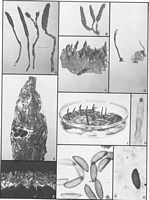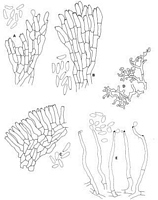|
 Xylaria apiculata Xylaria apiculata
BiostatusPresent in region - Indigenous. Endemic
Images (click to enlarge)
Caption: Fig. 8 Xylaria apiculata A, B, C, Stromata (A: PDD 41970, B: PDD 43161, PDD 43171). D,
Anamorphic stromata (PDD 44427). E, Stromal surface (PDD 41968). F, Hairs at base of
stroma (PDD 41968). G, Ascal ring (Melzer's reagent, PDD 41970). H, Asco | 
Caption: Fig. 12 Xylaria anamorphs A, X. schreuderiana (from culture, PDD 43183). B, C, D, X.
apiculata (B: PDD 44271 from culture, C, PDD 44322 from nature, D, Sterile hairs
formed in cultures, PDD 44322). E, X. palmicola (PD |
Description: Stromata: Stromata upright (taller than broad) (apex apiculate); stipitate; 10-60 mm tall; 2-3 mm diam.; perithecia not visible; ostioles lower than or more or less equal to stromatal surface; stromatal surface wrinkled; dark brown (brown vinaceous), or blackish; KOH-extractable pigments lacking; tissue below perithecia conspicuous, essentially homogeneous, white.
Perithecia: Perithecia more or less globose; 0.4-1 mm diam.
Asci: Stipe long with spores more or less confined to upper half of ascus, or stipe short with spores filling about two-thirds of ascus; amyloid ring higher than broad.
Ascospores: Ascospores 20-25 µm long; 6.5-8 µm wide; brown; 0-septate; in side view inequilateral, flattened on one side, not curved, or inequilateral, flattened on one side, curved (slightly); in face view elliptic; ends narrowly rounded. Germ slit straight, spore-length; on flattened side of spore. Perispore indehiscent in 10% KOH.
Article: Rogers, J.D.; Samuels, G.J. (1987) [1986]. Ascomycetes of New Zealand 8. Xylaria. New Zealand Journal of Botany 24(4): 615-650 (http://www.rsnz.org/publish/abstracts.php).
Description: Stromata gregarious and sometimes fasciculate to solitary and scattered, unbranched,
dichotomously branched, or palmately branched, 1-4(-6) cm long; tip at first
conidiogenous. Fertile portion subapical, cylindrical in section, 1-2(-5) cm long x 2-3 cm
diam., rounded or apiculate at apex, apiculus 2-3 mm long; at first brown and with brown
hairs, later hairs not evident and brown tissue splitting longitudinally; perithecia completely
immersed, 400-1000 µm diam., ostioles umbilicate, difficult to see. Internal tissue of
stroma white, solid. Stipe sharply delimited from fertile portion, wiry, 1-1.5(-2) mm diam.;
at first with stiff, erect, setose, brown hyphal hairs; hairs not evident on old material.
Asci 229-280 µm total length x (5-)7-9(-10) µm, sporiferous part 120-180 µm, cylindrical;
8-spored, apical ring J +, cylindrical, (3.5-)4-5 µm high x 34(-5) µm'wide; ascospores
uniseriate with overlapping ends. Ascospores (16.0-)20.0-24.5(-30.0) x (5.0-)6.78.0(-9.0)
µm, inequilateral with one side flat to concave and the other side curved, elliptical in top
view; one-celled or occasionally with an inconspicuous cellular appendage (primary
appendage) on one end, transparent brown; slit somewhat less than full length or full
length, parallel to long axis of ascospore or slightly undulate. Conidiogenous cells in vivo
forming a compact palisade c. 25 µm deep, comprising branched, light brown, smooth
conidiophores; each branch terminating in a conidiogenous cell; conidiogenous cells 11-19
x 2.5-3.0 µm, cylindrical; conidiogenous loci terminal, with a 0.5-1.0 µm diam., refractive
circular scar remaining after conidial dehiscence. Conidia (4.0-)5.2-7.7(-10.0) x (1.5-)
1.8-2.3(-3.0) µm, ellipsoidal to oblong, the apex sometimes slightly hooked or beaked; pale
brown, smooth; each conidium with a protuberant, 0.5-1.0 µm wide, refractive, frill-like,
basal abscission scar.
CHARACTERISTICS IN CULTURE: Colonies grown 2 weeks at 20°C in diffuse daylight
on OA 3-5 cm diam., mycelium dark green to black over most of the colony except white at
the margin, aerial hyphae with much-branched tips and with long, stiff, erect, unbranched,
acute hyphal hairs scattered throughout the colony. Stromata not forming or sterile stromata
forming within 1 month, then poorly developed or robust, cylindrical, tapering to an acute
apex, to 2 cm long, covered with stiff, erect, black, setose hyphae. Conidia rarely forming
in culture.
Habitat: HABITAT: On decaying, decorticated wood of dicotyledonous trees, less frequently on
vines of Ripogonum scandens J. R. & G. Forst. (Smilacaceae) and on stems of Freycinetia
baueriana Endlicher var. banksii (A. Cunn.) B. C. Stone (Pandanaceae). More common in
mixed podocarp forests than in Nothofagus forests.
Distribution: DISTRIBUTION: NORTH ISLAND: Northland, Auckland, Coromandel, Bay of Plenty,
Waikato, Gisborne, Wellington. SOUTH ISLAND: Nelson, Westland.
Notes: Xylaria apiculata is among the most common species in New Zealand. It was
originally described from New Zealand; the holotype has been examined [New Zealand
(K)]. The fungus listed by Berkeley (Hooker 1855) as X. multiplex (Kunze) Fr. was
probably X. apiculata; X. multiplex has not been seen µmong collections examined by us.
Since its description X. apiculata has been reported from various parts of the world and is
especially common in South µmerica. It is probable that several taxa will be found to be
included under this name. Moreover, X. apiculata is related to X. arbuscula, X.
schreuderiana, and X> zealandica, described elsewhere herein. These taxa are apparently
components of a species complex.
Martin (1970) cultured X. apiculata. His description differs from ours in that colonies were
reported to be pure white and conidia were not observed.
|